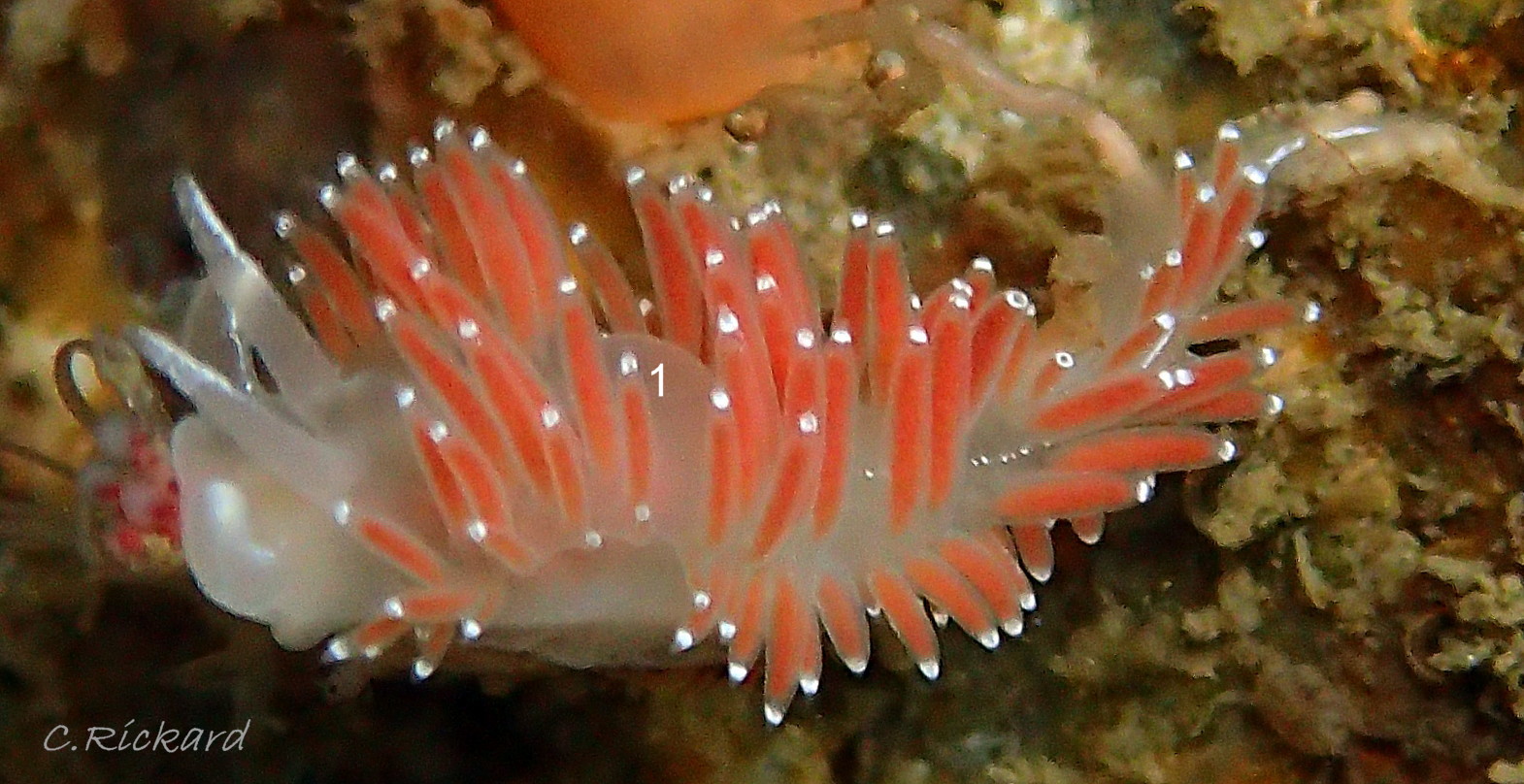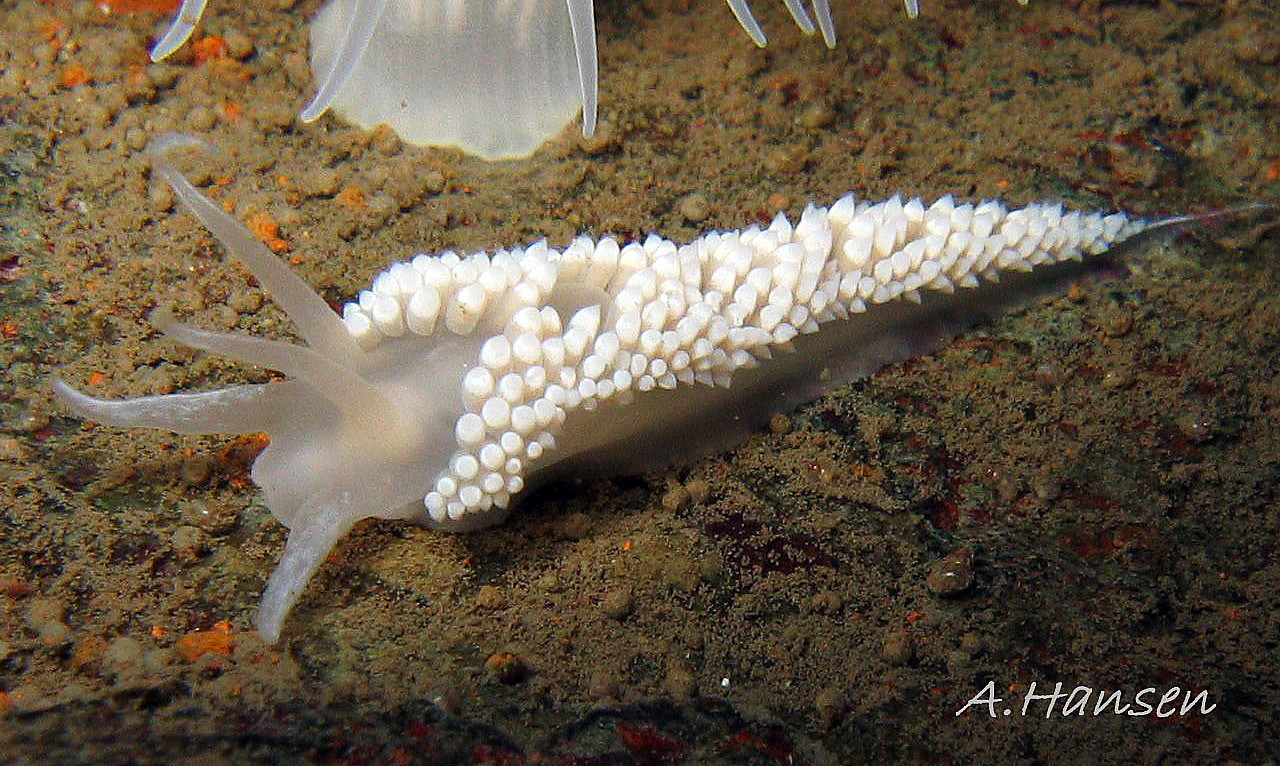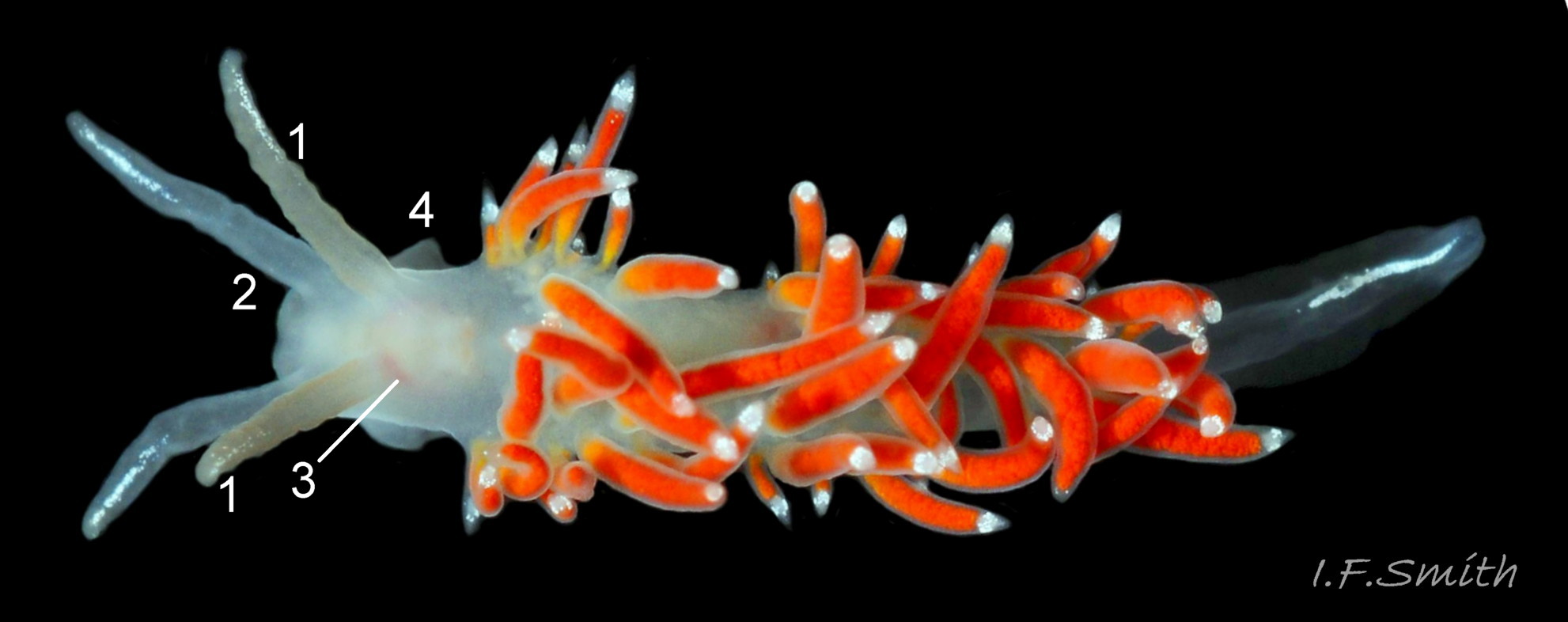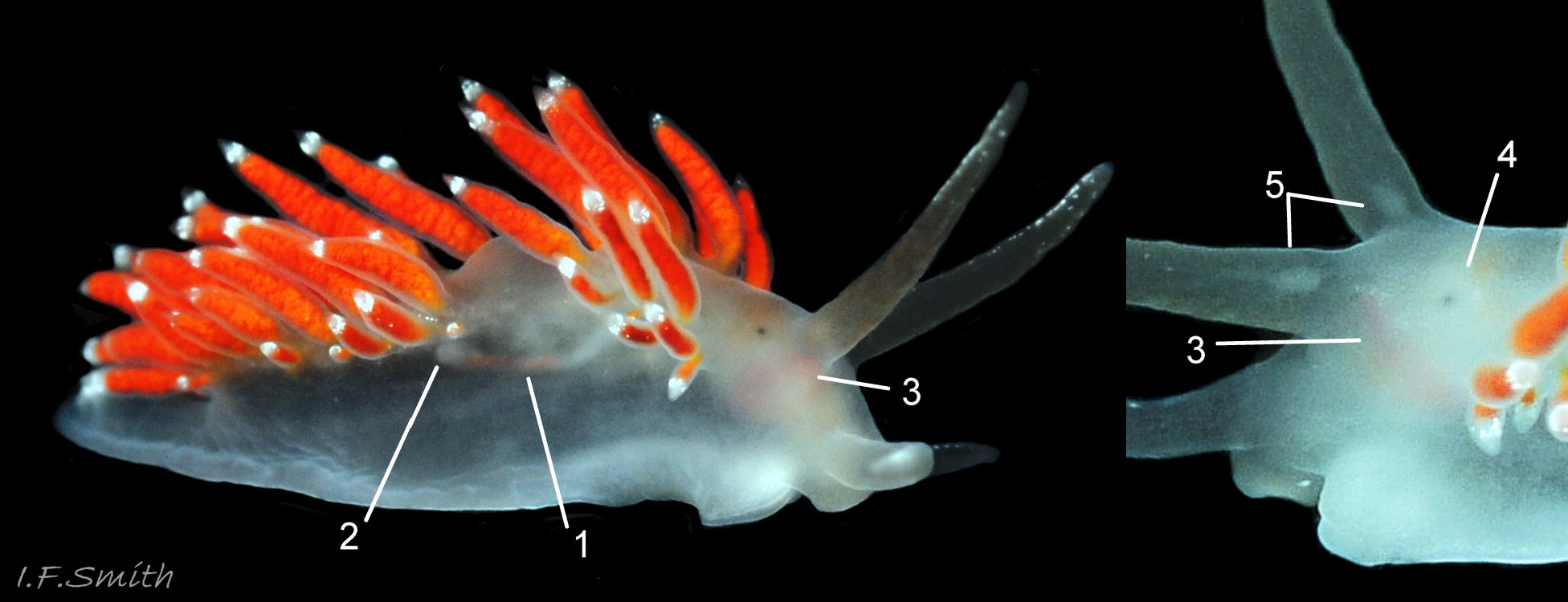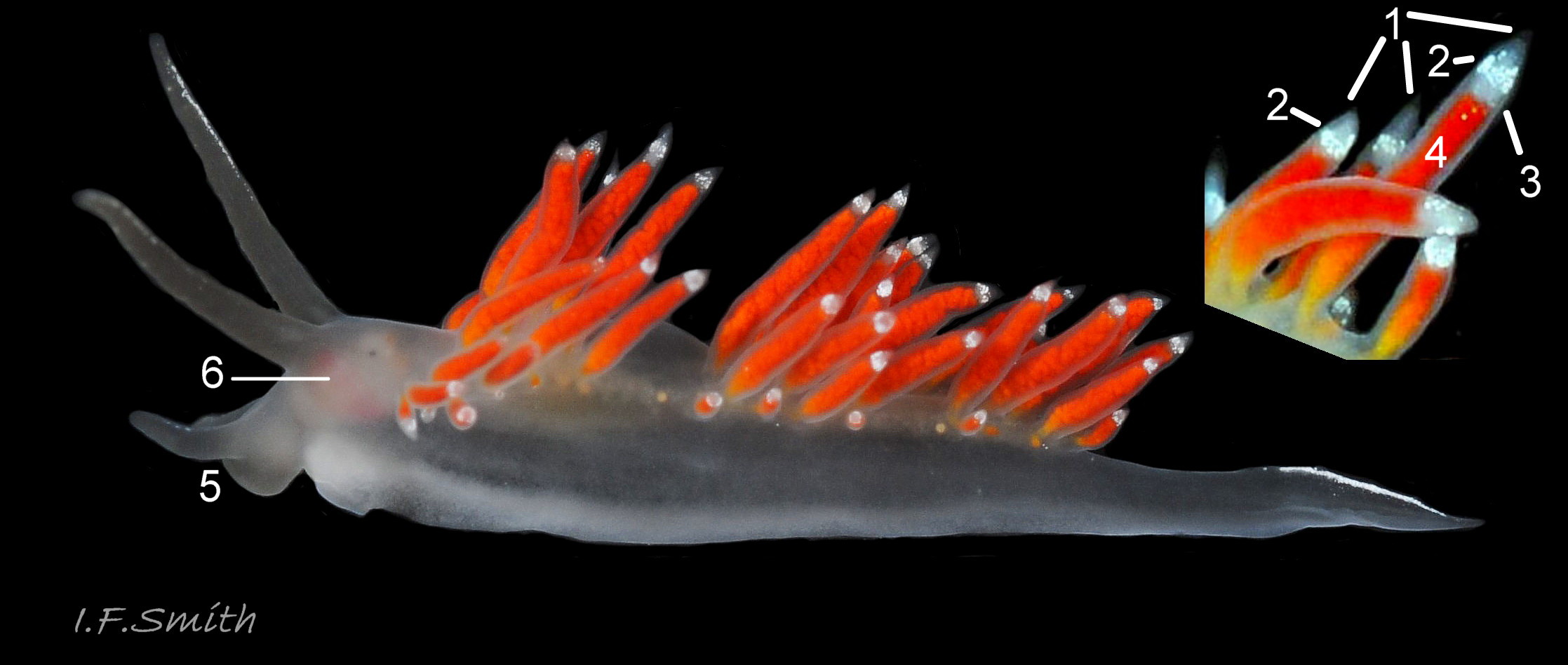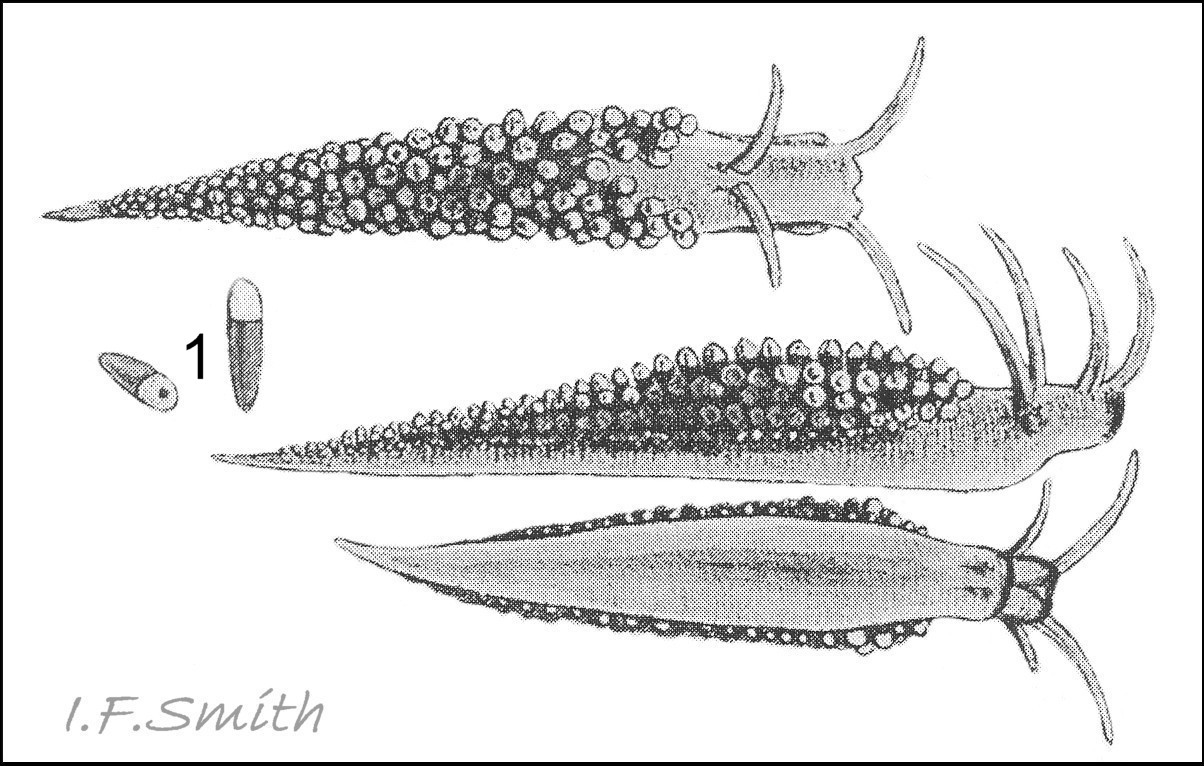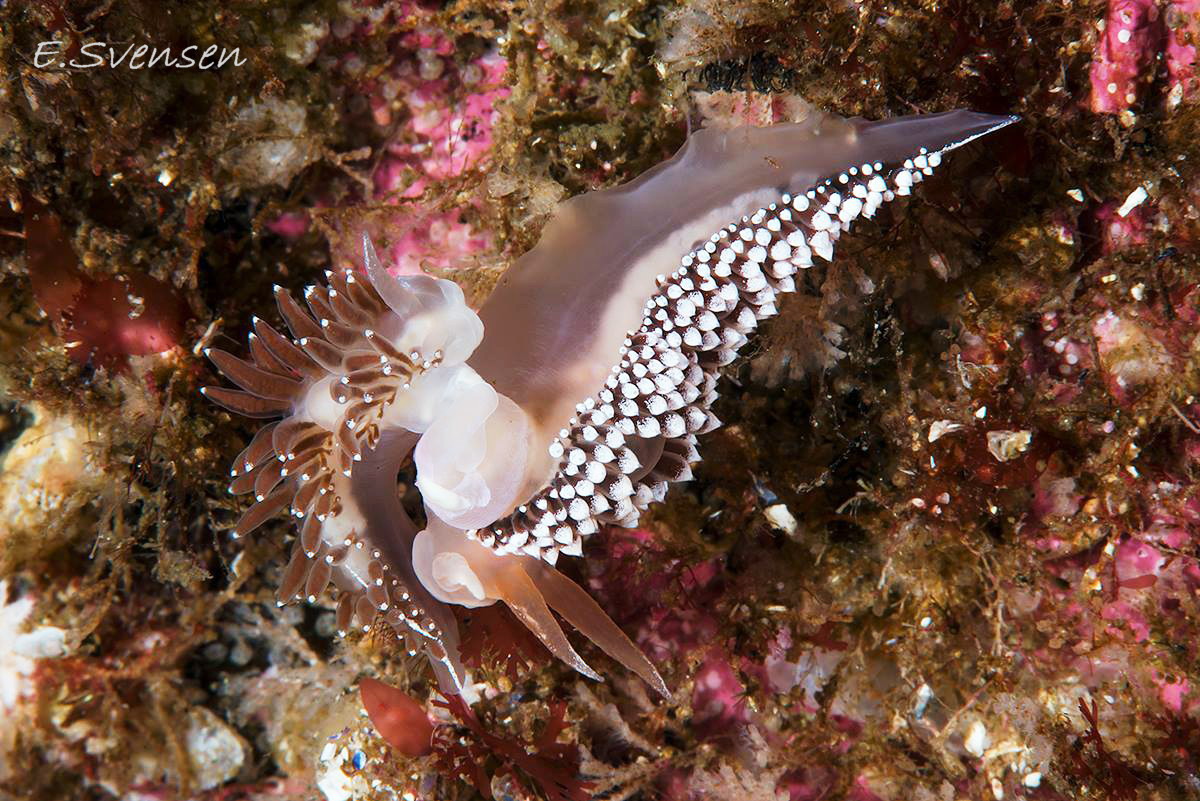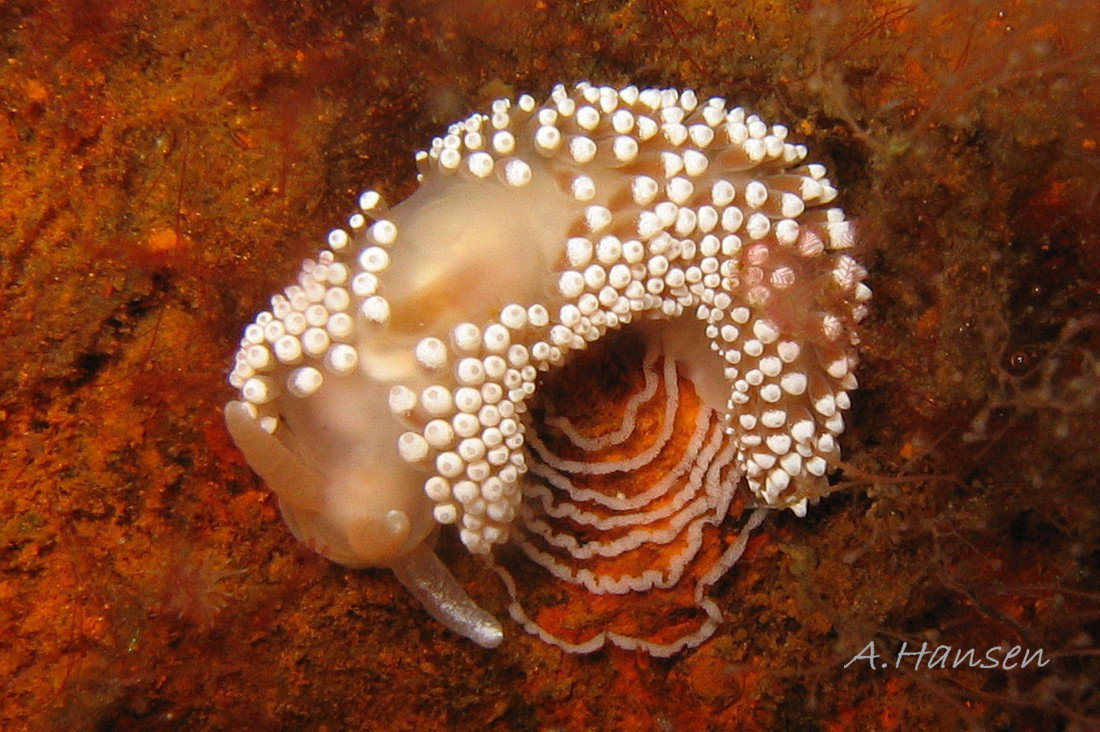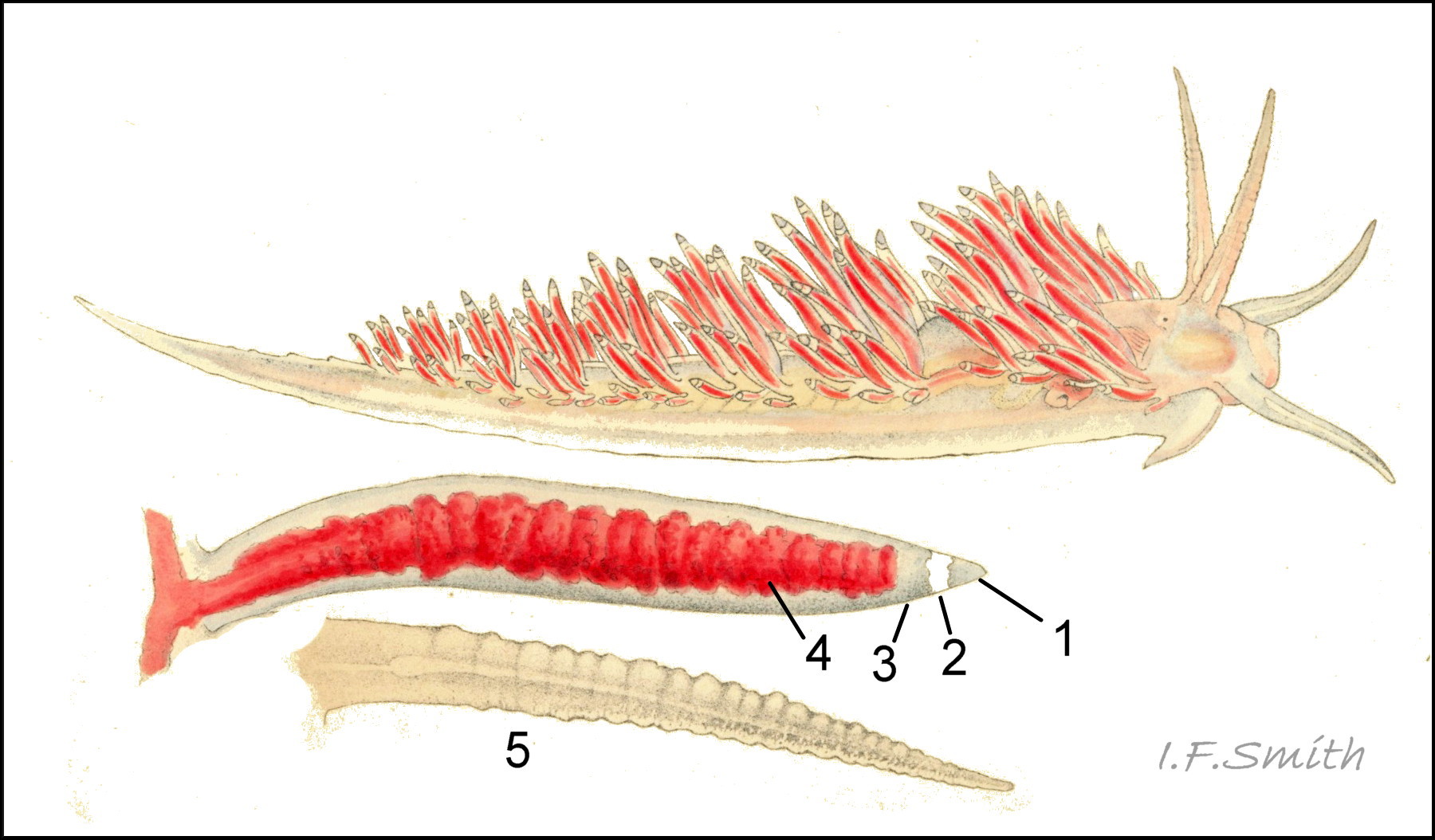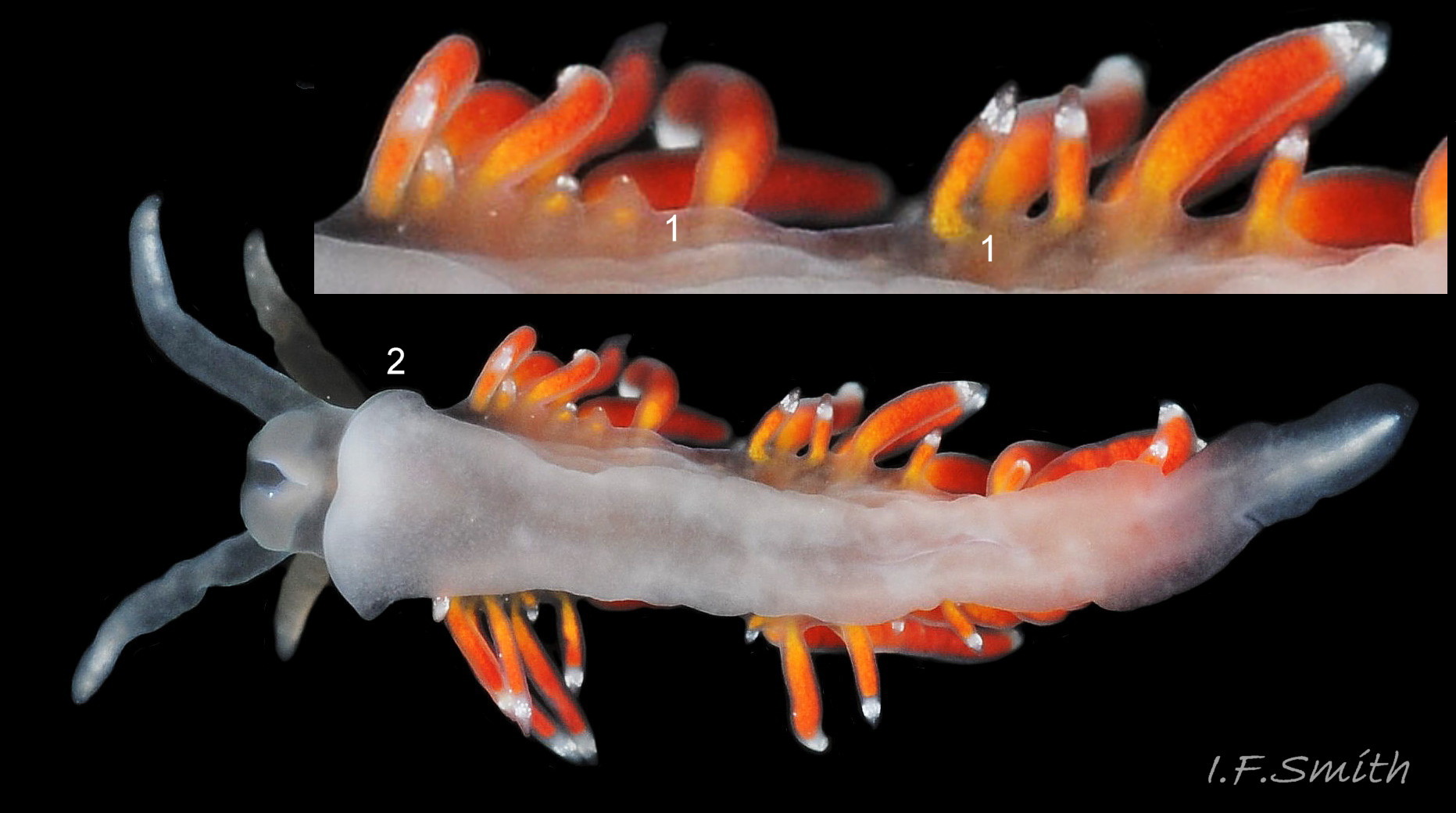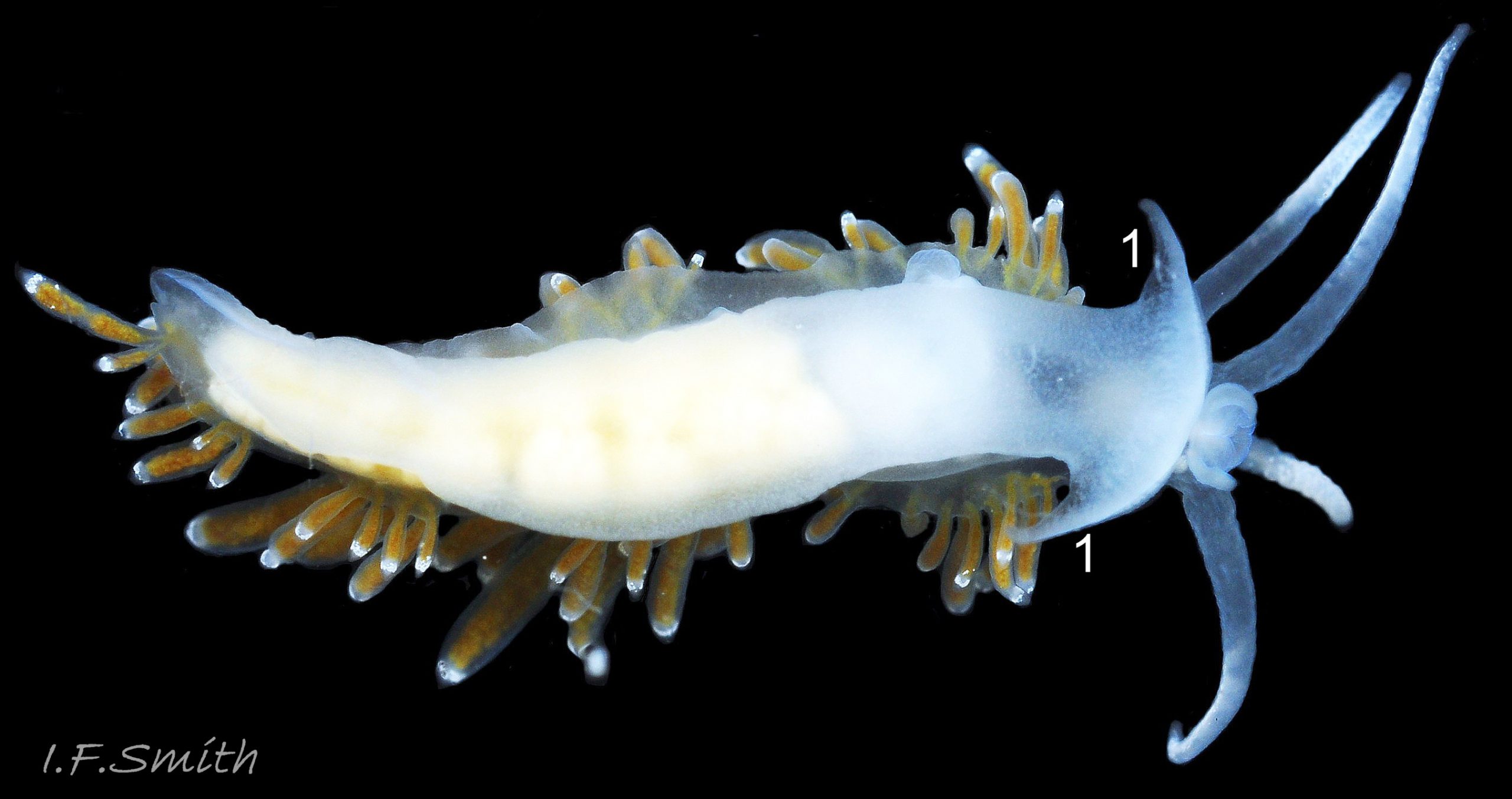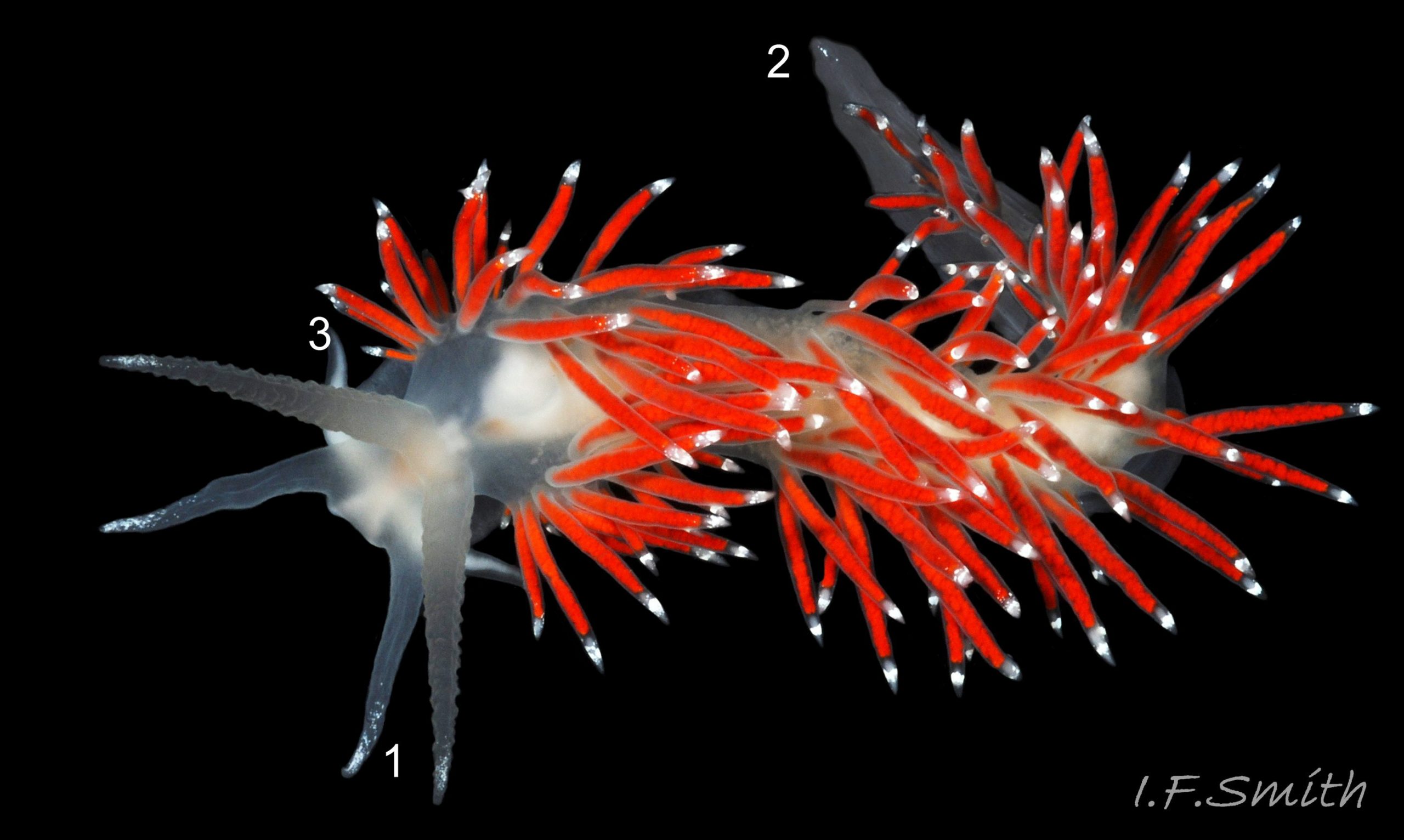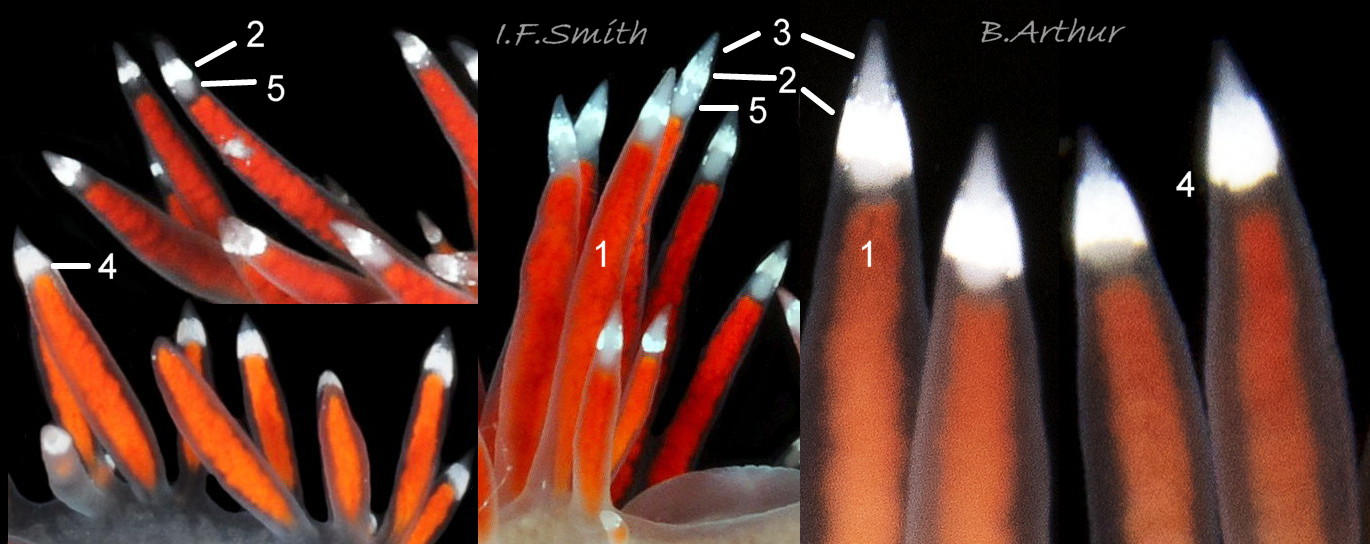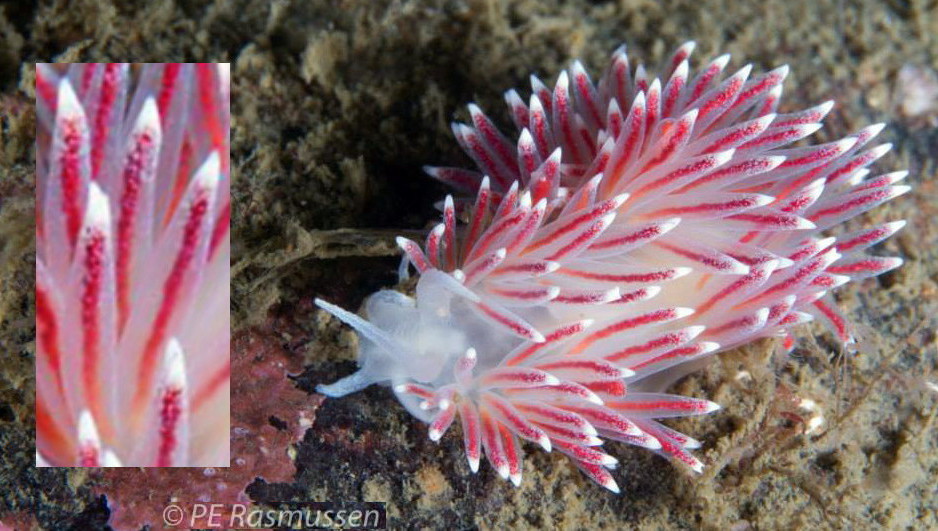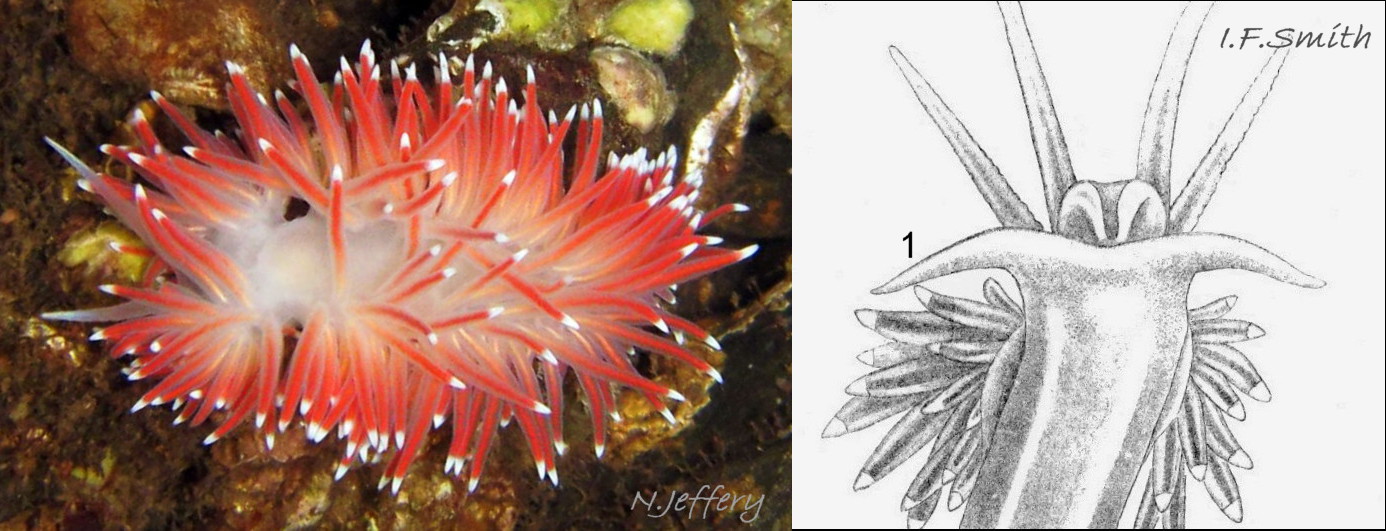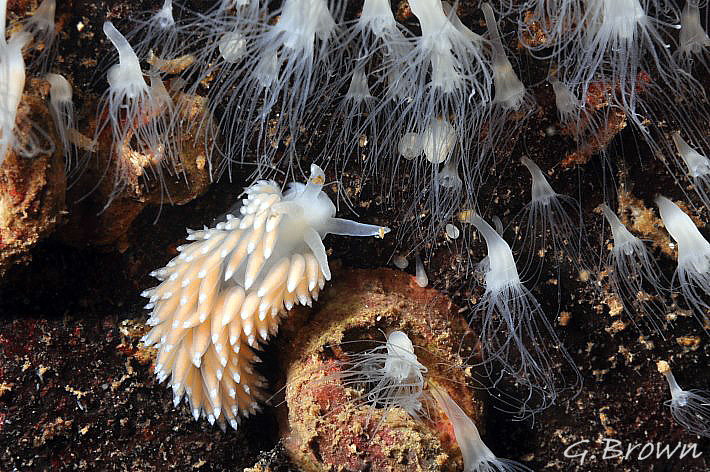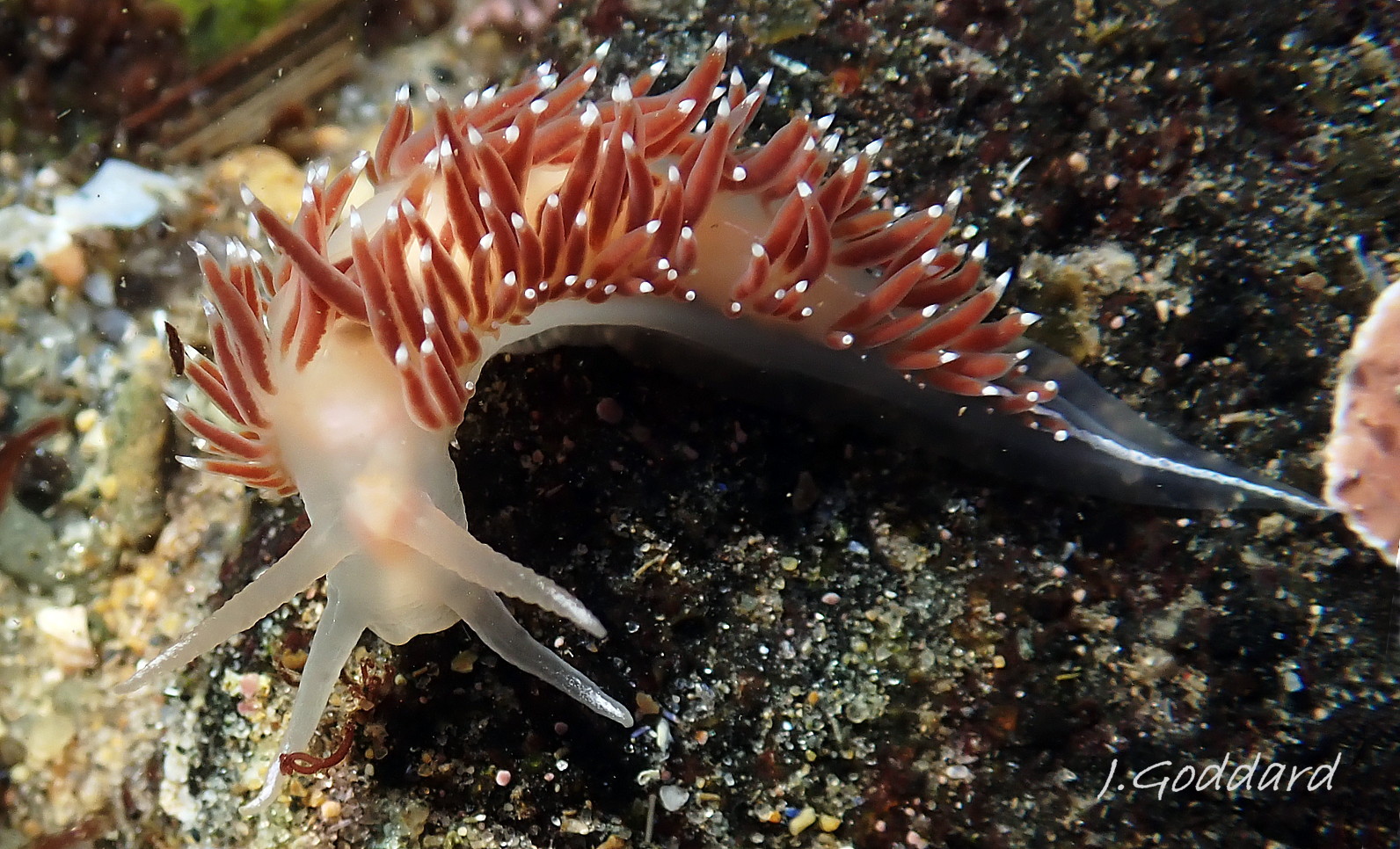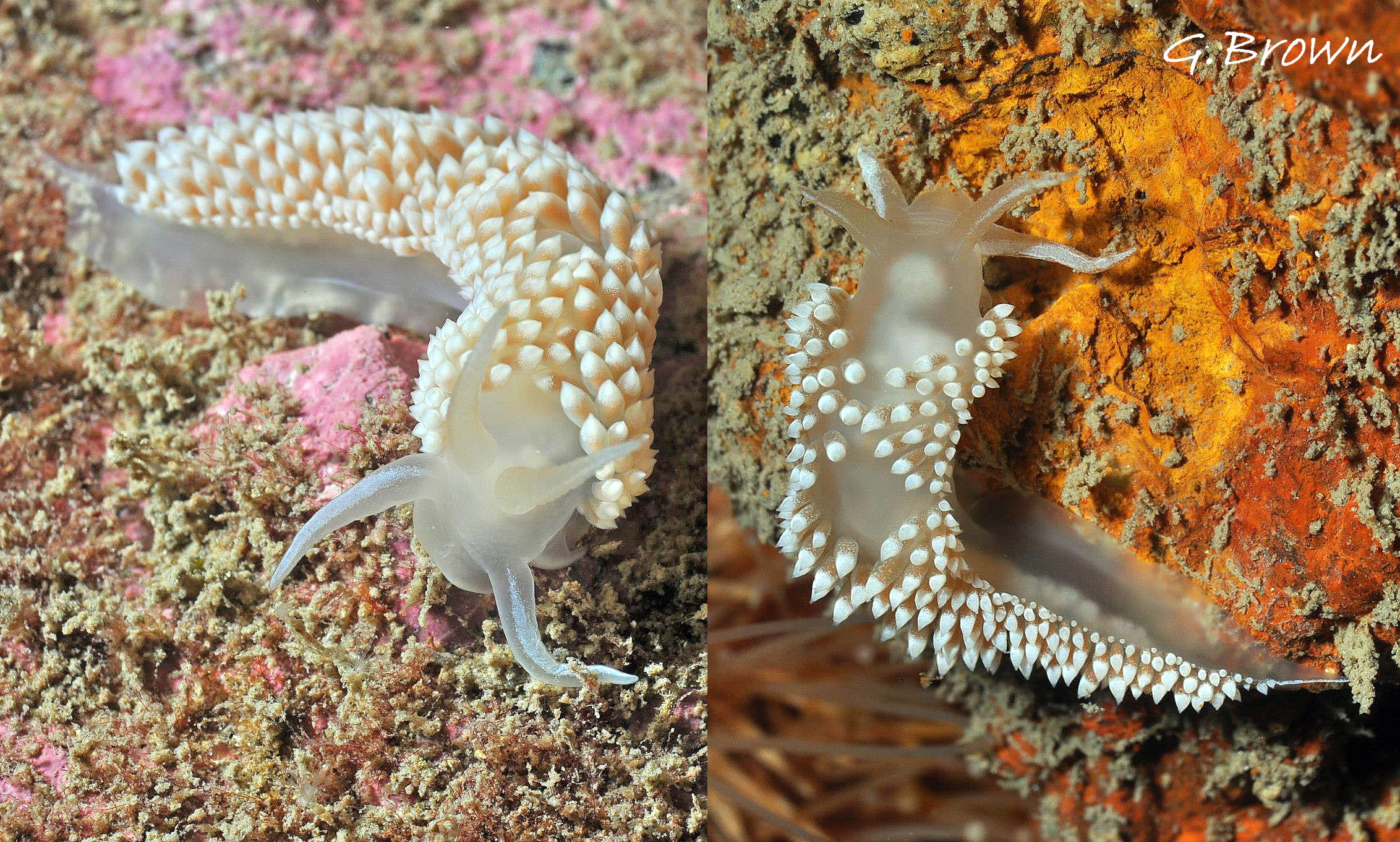Click image to enlarge with full caption. Main text below slider.
Coryphella verrucosa (M. Sars, 1829).
Including forms Coryphella verrucosa verrucosa (M. Sars, 1829) and Coryphella verrucosa rufibranchialis (G. Johnston, 1832).
PDF available at www.researchgate.net/publication/361247558_Coryphella_ver…
Current taxonomy: World Register of Marine Species www.marinespecies.org/aphia.php?p=taxdetails&id=139987
Synonyms: Eolidia verrucosa M. Sars, 1829; Eolis rufibranchialis G. Johnston, 1832; Coryphella rufibranchialis (G. Johnston, 1832); Coryphella rufibranchialis chocolata Balch, 1908: Coryphella pseudoverrucosa Martynov, Sanamyan & Korshunova, 2015; Flabellina verrucosa (M. Sars, 1829); Flabellina pseudoverrucosa (Martynov, Sanamyan & Korshunova, 2015).
GLOSSARY BELOW
Preface
The following description is primarily of Coryphella verrucosa rufibranchialis, the only form found in Britain except Shetland, where the Scandinavian form with radically different cerata, Coryphella verrucosa verrucosa, also occurs. The cerata of the two forms are described separately; other features are similar on both forms.
Description
The length, excluding appendages, may reach 25 mm, occasionally 35 mm. The body is translucent white, revealing white ovotestes when mature 01 Coryphella verrucosa rufibranchialis . The tail has an opaque white, substantial, dorsal line. On well grown adults the dorsal line may continue, often with breaks, as far the hump over the pericardium 02 Coryphella verrucosa rufibranchialis , but often ( usually on Coryphella verrucosa verrucosa) the dorsum is obscured by cerata 03 Coryphella verrucosa verrucosa . The dorsal line often does not extend the full length of the tail on young specimens 04 Coryphella verrucosa rufibranchialis . On translucent, immature specimens, the rectum ending at the anus below the second group of cerata on the right, the pink jaw, the circum-oesophageal nerve ring bearing black internal eyes and the rhinophoral ganglia on nerve cords connected to the nerve ring may be discernible 05 Coryphella verrucosa rufibranchialis .
The cerata on C. v, rufibranchialis are slender, almost linear, about as long as the width of the body, and held at varying angles, often across each other 04 Coryphella verrucosa rufibranchialis . They are arranged in five to seven groups of diagonal rows on each side of the body 01 Coryphella verrucosa rufibranchialis & 06 Coryphella verrucosa rufibranchialis , rising from a notal ridge which does not continue between ceratal groups 12 Coryphella verrucosa rufibranchialis . The digestive gland within the cerata can be various shades of red 02 Coryphella verrucosa rufibranchialis or red-brown 01 Coryphella verrucosa rufibranchialis . A narrow, opaque white, subterminal pigment band encircles the translucent white tip containing cnidosacs 01 Coryphella verrucosa rufibranchialis & 06 Coryphella verrucosa rufibranchialis , and there may be a translucent gap between the band and the digestive gland.
The cerata on C. v. verrucosa are stout and cylindrical with a slightly narrower base and an obtuse tip 07 Coryphella verrucosa verrucosa . They are barely as long as half the width of the body and are held erect and packed densely together (Sars, 1829) 03 Coryphella verrucosa verrucosa . They are attached along either side of the body, but it looks as if the whole back [apart from hump over pericardium] is occupied by them (Sars, 1829). They are so packed together that it is not possible to discern an arrangement of groups or lines (Sars, 1829). The digestive gland can be dark brown 08 Coryphella verrucosa rufibranchialis , rust-brown 09 Coryphella verrucosa verrucosa or white 03 Coryphella verrucosa verrucosa . The whole tip is covered by a substantial cap of opaque white, except for a small, translucent apex which, when viewed end on, can reveal the brown digestive gland 09 Coryphella verrucosa verrucosa as the ‘brown spot’ recorded by Sars (1829).
The wrinkled translucent whitish rhinophores 10 Coryphella verrucosa rufibranchialis are slightly yellowish 04 Coryphella verrucosa rufibranchialis , sometimes pinkish, with an opaque white line along the distal third.
Translucent white oral tentacles arise from the upper surface of the head 06 Coryphella verrucosa rufibranchialis . They have an opaque white line along the distal third 04 Coryphella verrucosa rufibranchialis . The prominent outer parts of the mouth occupy most of the head ventrally 11 Coryphella verrucosa . The internal pink jaw can sometimes be discerned in the translucent head as a pink band in lateral view 06 Coryphella verrucosa rufibranchialis and a forward pointing ‘V’ in dorsal view 04 Coryphella verrucosa rufibranchialis .
The long, slender, translucent white foot is widest at the bilaminate anterior from whence it tapers gradually to a fine posterior point 12 Coryphella verrucosa rufibranchialis . It has propodial swellings which Thompson and Brown (1984) illustrate with a drawing and description of them as ‘propodial tentacles’ projecting ‘about half the width of the foot on either side’. This degree of extension has not been observed by I.F.S. and the greatest extension visible in images in this account is about 17% of body width in dorsal view 04 Coryphella verrucosa rufibranchialis . The drawing in Alder and Hancock (1844-1854) shows propodial tentacles 30% of body width, the image in Sars (1829) shows barely any swelling and some photos show swellings that can hardly be described as tentacles 11 Coryphella verrucosa .
Key identification features
Of Eolis rufibranchialis Alder and Hancock (1844-1854) wrote “This beautiful species has been much misunderstood. – – we suspect that he [G. Johnston, 1832] has included more than one species under the – – name – – and the same course has been followed by other authors.” Over a century later, uncertainty remains, especially if other similar species or forms from Norway and America are included.
Coryphella verrucosa rufibranchialis
1) Cerata as long as the width of the body, and held at varying angles, often across each other 04 Coryphella verrucosa rufibranchialis .
2) Cerata have a narrow, subterminal, opaque white ring 01 Coryphella verrucosa rufibranchialis & 06 Coryphella verrucosa rufibranchialis .
3) Substantial white dorsal line on tail 04 Coryphella verrucosa rufibranchialis , sometimes a broken, white dorsal line on dorsum 02 Coryphella verrucosa rufibranchialis .
4) Propodial expansions sometimes form small propodial tentacles.
5) Recorded from Scandinavia, Britain, Bretagne and also Atlantic and Pacific coasts of North America, Bering Sea and Sea of Japan (Thompson and Brown 1984).
Coryphella verrucosa verrucosa
1) Cerata barely as long as half the width of the body, and held erect and packed densely together 03 Coryphella verrucosa verrucosa & 07 Coryphella verrucosa verrucosa .
2) Cerata have substantial cap of opaque white, except for a small, translucent apex 09 Coryphella verrucosa verrucosa .
3) Continuous white dorsal line on tail. Dorsal body, apart from hump over pericardium, concealed by dense tubercles 03 Coryphella verrucosa verrucosa & 08 Coryphella verrucosa rufibranchialis & Coryphella verrucosa verrucosa .
4) Small propodial expansions.
5) Confined to Scandinavia and Shetland.
Intermediate between C. v. rufibranchialis and C. v. verrucosa
Occasionally forms intermediate between C. v. verrucosa and C. v. rufibranchialis have been reported in Scandinavia where the two forms are sympatric. Some may have been individuals re-growing cerata after damage.
Similar species
Coryphella gracilis (Alder and Hancock, 1844)
13 Coryphella verrucosa & 14 Coryphella verrucosa .
1) Cerata length about same as body width. Narrowed at base so sometimes elliptical, and less slender and flexible than cerata on C. v. rufibranchialis. Arise from a pronounced notal ridge containing the digestive gland.
2) Digestive gland in cerata rather granular, colour varies red to, often, brownish orange or green. Narrow subterminal opaque white ring on cerata.
3) Opaque white dorsal line on tail is sometimes fragmentary or missing. No line on rest of body. Matures at small size, so white ovotestes are visible when 8 mm long, at which size ovotestes are usually missing in juvenile C. verrucosa.
4) Distinct tapering propodial tentacles, length nearly as great as body width.
5) Scattered records around Britain and Ireland. Few or none in southern half of east coast England and north-east Irish Sea.
Coryphella browni Picton, 1980. 15 Coryphella verucosa& 16 Coryphella verucosa
1) Cerata length up to twice the body width.
2) Broad white band on cerata distally, but no pigment on apex.
3) Interrupted white medial line, often reduced to a few dots or none, on tail. No line on rest of body.
4) Distinct tapering propodial tentacles, length about 25% of body width.
5) Scattered records around Britain and Ireland. Few or none in southern half of east coast England and north-east Irish Sea.
Carronella pellucida (Alder & Hancock, 1843). 17 Coryphella verrucosa & 18 Coryphella verrucosa
1) Cerata length greater than width of body.
2) White pigment covers entire distal end of cerata.
3) Opaque white dorsal line on tail. No line on rest of body.
4) Long tapering propodial tentacles as long as, or longer than, width of body.
5) Scandinavia and Scotland; the few English records on NBN are probably misidentifications.
Other similar species
A similar, uncertain species, which occurs in Scotland, Scandinavia and possibly Iceland, feeds on the scyphistoma polyp phase of Aurelia aurita (Linnaeus, 1758)
19 Coryphella verrucosa
In Scandinavia the following similar species, some of which are poorly known, also need consideration: Berghia norvegica Odhner, 1939; Coryphella borealis Odhner, 1922 Coryphella nobilis A. E. Verrill, 1880 and Ziminella salmonacea (Couthouy, 1838). Some are illustrated at www.seawater.no/fauna/mollusca/norvegica.html . Some of these and other species need consideration in North America.
Habits and ecology
C. verrucosa lives on rocky substrate at LWS and sublittorally (C. v. verrucosa to 450 metres in Scandinavia) where strong currents favour its principle prey; Tubularia indivisa. Many other hydroid species are eaten, especially by juveniles. Like other nudibranchs, it is a simultaneous hermaphrodite. The spawn of both forms is a thin line arranged as a smooth spiral on flat rock 09 Coryphella verrucosa verrucosa , or looped around hydroids. C. v. rufibranchialis breeds from April to June in Britain (Thompson & Brown, 1984). Veliger larvae drift for about ten days before metamorphosing.
Distribution and status
C. v. rufibranchialis, or species or forms resembling it, is recorded, often as C. verrucosa, from Scandinavia, Britain, Bretagne and also Atlantic and Pacific coasts of North America 20 Coryphella verrucosa rufibranchialis , Bering Sea and Sea of Japan (Thompson and Brown 1984). It is fairly frequent sublittorally in Britain and Ireland, and sometimes at LWS. C. v. verrucosa is confined to Shetland 21 Coryphella verrucosa verrucosa and Scandinavia, where it is frequent and sympatric with C. v. rufibranchialis.
Appendix, taxonomic history
Coryphella verrucosa (as Eolidia verrucosa) was first described and illustrated 07 Coryphella verrucosa verrucosa by Sars (1829) from specimens in Norway, where it is still frequently found 03 Coryphella verrucosa verrucosa .
Eolis rufibranchialis was first described by Johnston (1832) from a specimen in Berwick, England. He described the cerata as long, thus differing from the short stout cerata of Eolidia verrucosa Sars, 1829.
Alder and Hancock (1844-1854) described and illustrated Eolis rufibranchialis Johnston, 1832 more fully 10 Coryphella verrucosa rufibranchialis .
Winckworth (1932) brought the two species together as Coryphella verrucosa (M. Sars, 1829) in Norway and subspecies Coryphella verrucosa rufibranchialis (Johnston, 1832).
Odhner (1939) did as Winckworth, using the names Coryphella verrucosa verrucosa and Coryphella verrucosa rufibranchialis for the forms, both of which occur in Norway. Odhner wrote “ Since Løyning (1922) has found, in living material, transitions between C. verrucosa M. Sars and C. rufibranchialis Johnston, and since I have observed the same in Trondheimsfjord, it is evident that the two forms cannot be upheld as distinct species. – – The older name is that of Sars and has to be accepted instead of the generally used one, quite as Winckworth (1932) has done: the two extreme forms are thus given the names Coryphella verrucosa verrucosa and Coryphella verrucosa rufibranchialis, as to the short or elongate form of the papillae [cerata].”
Thompson and Brown (1976) used the form names of Odhner, but they gave an image of Coryphella verrucosa rufibranchialis the label Coryphella verrucosa var. verrucosa, unaware that the latter is absent from Britain, except Shetland
Picton (1980) described a new species, Coryphella browni, which previously would probably have been identified as Coryphella verrucosa rufibranchialis.
Thompson and Brown (1984) omitted use of the variety category and combined both forms, along with other forms from Atlantic and Pacific coasts of North America, Arctic Russia and the Sea of Japan, under the species name Coryphella verrucosa (M. Sars, 1829). Their description is of, only, Coryphella verrucosa rufibranchialis, and they stated their disagreement with Odhner’s accurate description of the cerata of Coryphella verrucosa verrucosa, presumably, because they had not seen live specimens of it with its very different cerata.
None of the images of C. verrucosa from north-east America 20 Coryphella verrucosa rufibranchialis on iNaturalist (accessed May 2022) are of the C. v. verrucosa form. Some match the morphology of European C. v. rufibranchialis.
Eriksson et al. (2006) wrote, “The conspecificity of two forms of Flabellina verrucosa (M. Sars, 1829), one form with short and one with long cerata, was tested by sequencing the mitochondrial COI and the nuclear 5.8S-ITS2 genes. We could not establish any genetic differences between the two forms and conclude that they belong to the same species.” But, examination of other parts of the DNA sequence might show differences which correlate with the morphological differences (B. Picton, 2022. pers. comm., 1 June).
The sighting of intermediate forms and of mating between the two forms 08 Coryphella verrucosa rufibranchialis adds weight to regarding them as a single species, but such sightings are much rarer than would be expected if interbreeding were free and unhindered. Mating of different species of nudibranch with each other is occasionally observed and, as with them, it is unknown if mating of C. v. verrucosa with C. v. rufibranchialis produces viable offspring capable of reproduction.
World Register of Marine Species (accessed 26 May 2022) accepts as valid the names Coryphella verrucosa (M. Sars, 1829) and, as a subspecies, Coryphella verrucosa rufibranchialis (G. Johnston, 1832).
As the two forms are sympatric in Scandinavia and Shetland, yet retain their distinctness, there remains some uncertainty about their exact relationship. It would be a source for future interest if they were recorded separately.
Acknowledgements
For use of images I gratefully thank Billy Arthur, George Brown, Jeff Goddard, Asbjørn Hansen flic.kr/s/87eY , Nathan Jeffery, Tim Nicholson, Poul Rasmussen, Chris Rickard and Erling Svensen. I thank Simon Taylor for specimens. For valuable advice and help with literature I thank Bernard Picton and Miquel Pontes.
References and links
Alder, J. & Hancock, A. 1845-1855. A monograph of the British nudibranchiate mollusca. London, Ray Society. Family 3, plate 14. www.biodiversitylibrary.org/item/131598#page/338/mode/1up
Balch, F. N. 1909. A spring collecting trip. Notes on New England nudibranchs II. The Nautilus. 23(3): 33-38., [Original description of Coryphella rufibranchialis var. chocolata Balch, 1909]
p 35-36 www.biodiversitylibrary.org/page/5314618
page(s): 35-36, 38
Eriksson, R., Nuygren, A. & Sundberg, P. 2006. Genetic evidence of phenotypic polymorphism in the aeolid nudibranch Flabellina verrucosa (M. Sars, 1829) (Opisthobranchia: Nudibranchia). Organisms, Diversity and Evolution 6:1, 71-76
www.sciencedirect.com/science/article/pii/S1439609205000772
iNaturalist, Observations of Coryphella verrucosa. (accessed 25 May 2022) www.inaturalist.org/observations?taxon_id=633193
Johnston, G. 1832. Illustrations in British zoology London Mag. nat. His. 5: 428-429.
www.biodiversitylibrary.org/item/19519#page/464/mode/1up
Korshunova, T., Martynov, A., Bakken, T., Evertsen, J., Fletcher, K., Mudianta, W.I., Saito, H., Lundin, K., Schrödl, M. and Picton B. 2017. Polyphyly of the traditional family Flabellinidae affects a major group of Nudibranchia: aeolidacean taxonomic reassessment with descriptions of several new families, genera, and species (Mollusca, Gastropoda). ZooKeys 717: 1–139. doi.org/10.3897/zookeys.717.21885
Løyning, P. 1922. Nudibranch faunaen i Drøbaksundet I. Fam. Aeolididae, Skrifter utgrit av det Norske Vidensk. Akad. i Oslo
Odhner, N.H. 1922. Norwegian opisthobranchiate mollusca in the collection of the Zoologial Museum of Kristiana. Nyt. Mag. Naturv. 60: 1-47 [Coryphella rufibranchialis p30] www.biodiversitylibrary.org/item/109307#page/38/mode/1up
Odhner, N.H. 1939. Opisthobranchiate Mollusca from the western and northern coasts of Norway. Det Kgl. Norske Videnskabers Selskabs Skrifter 1: 1-92.
Sars, M. 1829. Bidrag til söedyrenes naturhistorie. 1: 9-12 & Plate 2 figs. 1-4 Bergen.
gdz.sub.uni-goettingen.de/id/PPN612886522?tify=
Thompson, T.E. & Brown, G.H. 1976. British opisthobranch molluscs. London, Academic Press.
Thompson, T.E. & Brown, G.H. 1984. Biology of opisthobranch molluscs 2. London, Ray Society.
Winckworth, R. 1932. The British marine mollusca. J. Conch. Lond. 19: 211-252.
Picton, B. E. (1980). A new species of Coryphella (Gastropoda: Opisthobranchia) from the British Isles. Irish Naturalists’ Journal. 20: 15-19.
Thompson, T.E. & Brown, G.H. 1984. Biology of opisthobranch molluscs 2. London, Ray Society.
Glossary
cerata = (sing. ceras) lobes on dorsum of aeolids and some other seaslugs.
circum-oesophageal nerve ring = ganglia-bearing nerve cord which encircles the oesophagus.
cnidocytes = explosive stinging cells of Cnidaria. en.wikipedia.org/wiki/Cnidocyte
cnidosac = storage capsule at tips of cerata of Aeolidiidae, but not Dotidae, for ingested unexploded cnidocytes.
digestive gland = large organ in gastropods which acts like the liver and pancreas in mammals to absorb food.
distal = away from centre of body or from point of attachment.
ganglia = (sing. ganglion) knots on a nerve cord containing sensory cell bodies that conduct impulses to innervate organs of the body.
lamellae = small plates on rhinophores.
LWS = low water spring tide, and level it falls to; two periods of a few days each month when tide falls lowest.
notal = (adj.) of the back.
notal ridge = ridge on dorsal surface.
notum = (of seaslugs) the dorsal surface.
ovotestis = (pl. ovotestes) hermaphrodite organ serving as both ovary and testis.
pericardium = sac containing heart, sometimes visible as a raised mound behind rhinophores in aeolid sea slugs.
propodial tentacles = tentacular, lateral extensions on anterior of the foot.
propodium = anterior portion of gastropod foot. (adj. propodial).
rhinophores = chemo-receptor tentacles on top of head of nudibranch.
veliger = shelled larva of marine gastropod or bivalve mollusc which moves by action of cilia on a velum (bilobed flap). Stage may be passed in plankton or within liquid-filled egg-capsule.

